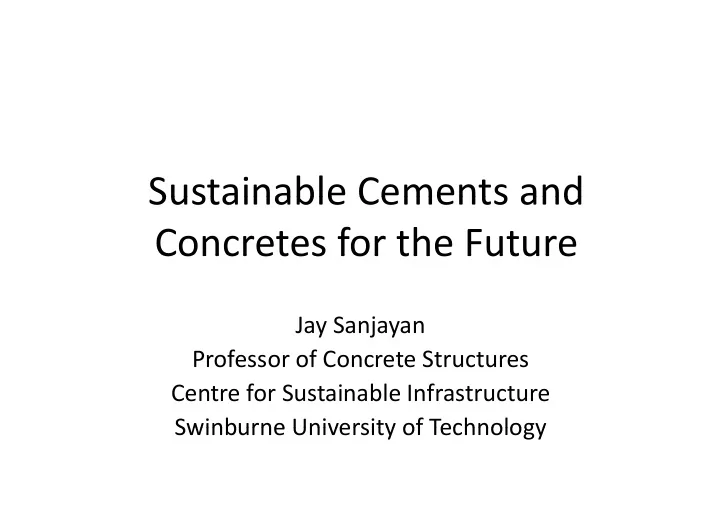

Sustainable Cements and Sustainable Cements and Concretes for the Future Concretes for the Future Jay Sanjayan Professor of Concrete Structures Centre for Sustainable Infrastructure Swinburne University of Technology Swinburne University of Technology
Global Materials Consumption p Concrete 22.4 Coal 6.8 Oil l 3.8 . . Steel 1.5 Plastic 0.3 0 5 10 15 20 25 Billion Tons / Year Sustainability?
CO 2 Emissions Breakdown 0.4000 0 4000 0.3500 0.3000 0 2500 0.2500 3 CO 2 -e/m 3 0.2000 t C 0.1500 0.1000 0.1000 0.0500 0.0000 25MPa 32MPa 40MPa 50MPa GP Cement GP Cement Coarse Aggregates Coarse Aggregates Fine Aggregates Fine Aggregates Concrete Batching Construction Activities Concrete Transport
CO 2 Emissions Breakdown 0.3500 0 3500 0.3000 0.2500 m 3 t CO 2 -e/m 0 2000 0.2000 0.1500 t 0.1000 0.0500 0.0000 25MPa 32MPa 25MPa 32MPa 25MPa 32MPa (FA) (FA) (GGBFS) (GGBFS) (GP) (GP) GP Cement GP Cement Fly Ash Fly Ash GGBFS GGBFS Coarse Aggregates Fine Aggregates Concrete Batching Construction Activities Concrete Transport
Cements without Portland cements Cements without Portland cements • Geopolymer / alkaline activated cements • Supersulfated cements Supersulfated cements • Calcium aluminate cements (CAC) • Calcium sulfoaluminate cements (CSA) • Magnesium oxy ‐ carbonate cements (MgO) Magnesium oxy carbonate cements (MgO)
Research in Geopolymer and/or Alkali A ti Activated Cements t d C t 150 s blications 100 earch Pub 50 50 Rese 0 1990 1995 2000 2005 2010 Year
Geopolymer Geopolymer • Alumino silicate source – metakaolin – fly ash – slag slag + • Alkaline activators – sodium hydroxide sodium hydroxide – sodium silicate No large capital investments in cement manufacture
Tensile Strength Tensile Strength
Elastic Modulus Elastic Modulus
Poisson’s ratio
Fracture Energy Fracture Energy
Characteristic Length g G E = F l ch 2 f f t
Sorptivity
Fire Resistance
Moisture Release in Concrete
Supersulfated cements Supersulfated cements • Slag (70 ‐ 80%) + Calcium sulfate (10 ‐ 20%) + Alkaline activator (<5%) • Alkaline Activator = Portland cement (<5%) • Alkaline Activator = Portland cement (<5%) • Slags, ideally >14% Al 2 O 3 • French standard: NF EN 15743:2010 • High sulphate resistance • High sulphate resistance Biogas Tank
Calcium aluminate cements (CAC) Calcium aluminate cements (CAC) • High Alumina Cement • Conversion: Conversion: – Metastable hydrates Stable hydrates • Expensive (uses bauxite) ( )
Calcium sulfoaluminate cements (CSA) Calcium sulfoaluminate cements (CSA) • Used and standardized in China for 30 years d d d di d i Chi f 30 • Limestone + Bauxite + Gypsum • Expensive • Clinkering temperature is reduced by 200 o C Clinkering temperature is reduced by 200 C • Expansive – shrinkage compensation shrinkage compensation – self prestressing • Lafarge produces combined Portland cement/CSA L f d bi d P tl d t/CSA – Aether TM (20 ‐ 30% less CO 2 )
Magnesium oxy carbonate cements Magnesium oxy ‐ carbonate cements • Sorel cements • Tec ‐ Eco cement Tec Eco cement • Novacem
What it means to Structural Engineers? • Concrete design is largely empirical, based on d i i l l i i l b d 200 years of experience, e.g. – Reinforcement detailing – Crack widths, <0.1 mm self ‐ healing – Crack width design: 300 mm reo spacing – Long ‐ term creep and relaxation Long term creep and relaxation – Cover • Empirical design is built on “standard” • Empirical design is built on standard Portland cement
Portland cement • Very tightly standardised: eg AS 3972 • Very tightly standardised: eg.,AS 3972
Empiricism in Concrete Structural Design Poisson’s ratio, ν =0.2 Thermal expansion = 10 με / o C Thermal expansion 10 με / C
Empiricism in Concrete Structural Design
Does AS3600 permits the use of alternative concretes?
AS1379 – 2007, page 15
Conclusions • The emergence of low carbon and alternative cements are inevitable. bl • We (concrete industry, structural designers, e (co c ete dust y, st uctu a des g e s, specifiers, educators) should embrace the new cements by cements by – knowledge and education – standards – caution
Recommend
More recommend